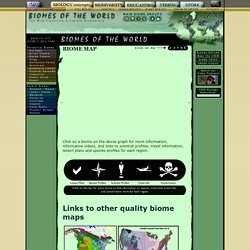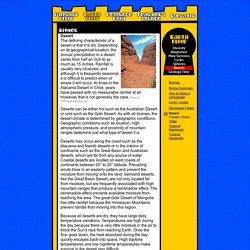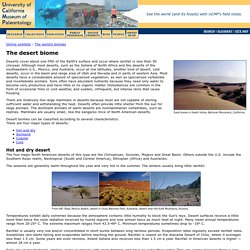

Deserts. Scientists often refer to large geographical areas with a distinct set of plants, animals, and climatic conditions as biomes.

There are four major terrestrial biomes: forest, grassland, tundra, and desert. Deserts cover about one-fifth of Earth's land area and are found in the driest places on the planet, where annual rainfall totals less than 20 cm (8 in). Desert landscapes are created and maintained by weathering and erosion. Desert Video & Map GREEN. Click on a biome on the above graph for more information, informative videos, and links to scientist profiles, travel information, lesson plans and species profiles for each region.

We'd like to know where you're coming from. If you've used this site for a class project or browsing for fun, add yourself to our map and communicate with other "ecogeeks" NatlGeo Maps: Explore a Pyramid. Ecosystem Tooter4Kids- Desert. Earth Floor: Desert Biome. Desert The defining characteristic of a desert is that it is dry.

Depending on its geographical location, the annual precipitation in a desert varies from half an inch to as much as 15 inches. Rainfall is usually very localized, and although it is frequently seasonal, it is difficult to predict when or where it will occur. At times in the Atacama Desert in Chile, years have passed with no measurable rainfall at all. However, that is not generally the case. Photo © 2000-www.arttoday.com Deserts can be either hot such as the Australian Desert or cold such as the Gobi Desert. Deserts may occur along the coast such as the Atacama and Namib deserts or in the interior of continents such as the Great Basin and Australian deserts, which are far from any source of water.
Because all deserts are dry, they have large daily temperature variations. Back | Next. Desert Biome. World Biomes- Desert. Desert Biome. Online exhibits : The world's biomes The desert biome Deserts cover about one fifth of the Earth's surface and occur where rainfall is less than 50 cm/year.

Although most deserts, such as the Sahara of North Africa and the deserts of the southwestern U.S., Mexico, and Australia, occur at low latitudes, another kind of desert, cold deserts, occur in the basin and range area of Utah and Nevada and in parts of western Asia. Most deserts have a considerable amount of specialized vegetation, as well as specialized vertebrate and invertebrate animals. Soils often have abundant nutrients because they need only water to become very productive and have little or no organic matter. There are relatively few large mammals in deserts because most are not capable of storing sufficient water and withstanding the heat. Desert biomes can be classified according to several characteristics.
The seasons are generally warm throughout the year and very hot in the summer. Canopy in most deserts is very rare. Desert Biome. In this report you will learn about Hot and Dry Deserts and Cold Deserts.

I hope you enjoy! A Hot and Dry Desert is, as you can tell from the name, hot and dry. Most Hot and Dry Deserts don't have very many plants. They do have some low down plants though. The only animals they have that can survive have the ability to burrow under ground. A cold desert is a desert that has snow in the winter instead of just dropping a few degrees in temperature like they would in a Hot and Dry Desert. Deserts cover about one fifth of the Earth's land surface. Hot and Dry Deserts temperature ranges from 20 to 25° C.